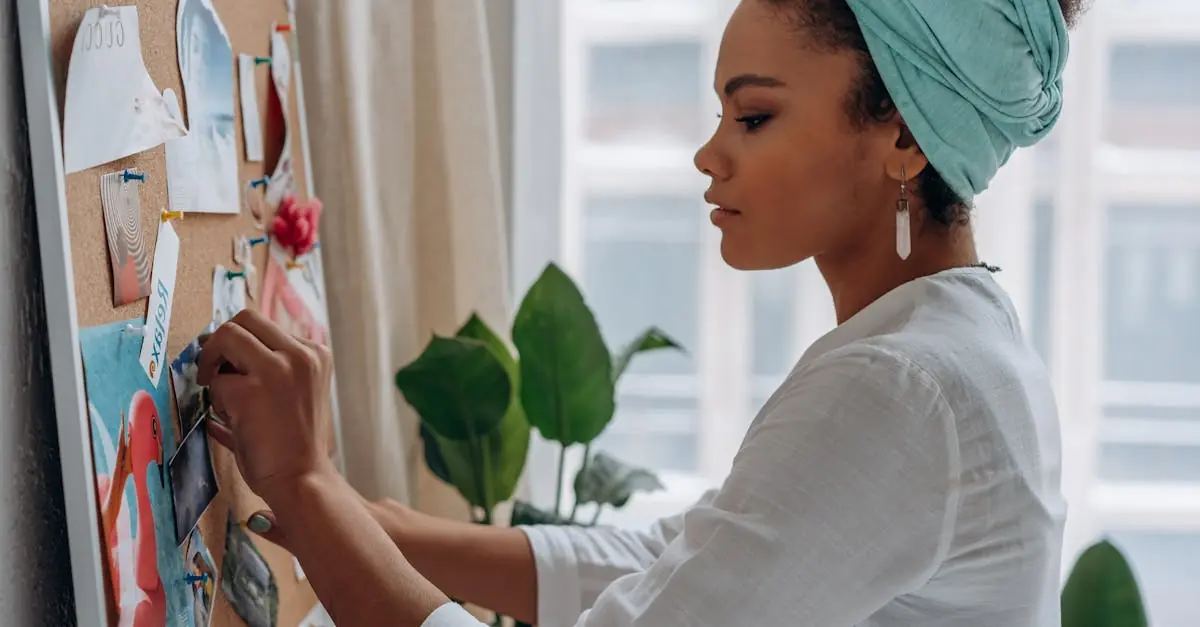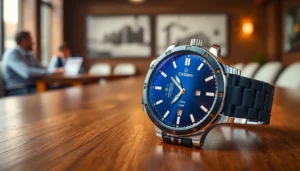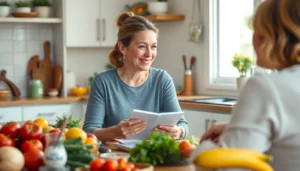Coasters: the unsung heroes of home decor. They bravely stand between your beloved furniture and those dreaded water rings, all while adding a splash of personality to your space. Why settle for store-bought when you can unleash your creativity with DIY coaster ideas? Not only do they protect your surfaces, but they also serve as conversation starters that’ll impress your guests—assuming they’re not too busy admiring your crafting skills.
From quirky cork creations to stunning stone masterpieces, the world of DIY coasters is as vast as your imagination. With just a few materials and a sprinkle of humor, anyone can transform everyday items into functional art. So grab your glue gun and get ready to elevate your coasters from mundane to magnificent—because who wouldn’t want to sip their drink while resting it on a work of art?
Table of Contents
ToggleCreative DIY Coaster Ideas
Explore various ideas to create unique coasters that elevate home decor. Cork coasters serve as an excellent base. Cut them into fun shapes or use stencils for artistic designs. This material absorbs moisture effectively, protecting furniture.
Tile coasters offer durability and a modern touch. Paint ceramic tiles with acrylic paints, then seal them with a waterproof sealant. Patterns can range from simple geometric shapes to intricate floral designs.
Wooden coasters provide a rustic charm. Sand down wooden slices and apply a food-safe finish for longevity. Personalizing them with wood burning creates lasting, custom keepsakes.
Fabric coasters combine softness with style. Use cotton fabric and a thick interfacing to add structure. Stitching designs or adding felt backing enhances their functionality.
Resin coasters allow for endless creativity. Mixing resin with pigments or glitter results in visually striking designs. Embed small items like flowers or buttons for a unique touch.
Upcycled materials make for eco-friendly options. Use bottle caps or old CDs as coaster bases, decorating them with paint or paper. This approach not only saves money but also reduces waste.
Paper coasters can be fun as well. Mod Podge can adhere scrapbook paper or photos to cardstock, creating personalized coasters. This method allows for quick and easy customization.
Engaging in these DIY projects turns ordinary materials into functional art. Each coaster idea highlights the blend of practicality and creativity. Explore these suggestions and enjoy crafting unique pieces that enhance any living space.
Material Options for Coasters
Coasters can be made from various materials, each providing unique benefits and aesthetics.
Wood Coasters
Wood coasters provide a rustic charm that complements many home styles. Different types of wood, like oak or bamboo, offer distinct looks and durability. Personalization options abound; wood burning or staining can create custom designs. Eco-conscious homeowners appreciate sustainably sourced wood, contributing to a more responsible lifestyle. They fit well in both casual and formal settings, enhancing any decor theme.
Cork Coasters
Cork coasters are lightweight and functionally absorbent. This material naturally traps moisture, preventing water rings on furniture. Available pre-cut or in sheets, cork can be easily customized, with options for cutting into various shapes or applying stencils. The eco-friendly nature of cork appeals to environmentally conscious individuals, as it is a renewable resource. These coasters come in neutral tones, blending seamlessly with any decor.
Resin Coasters
Resin coasters invite creative expression and customization. Artists can mix pigments, creating vibrant colors and unique patterns. Embedding small items like flowers or photographs adds a personal touch. Resin coasters offer a glossy finish, enhancing their visual appeal. The durability of resin ensures they withstand heat and moisture, making them practical for everyday use. Ideal for craft enthusiasts, these coasters provide endless design possibilities.
Step-by-Step DIY Instructions
Creating unique coasters can be an enjoyable project. The following ideas bring creativity to everyday items.
Simple Painted Coasters
Start with plain cork or wooden coasters. Use acrylic paint in vibrant colors. Applying a base coat provides a smooth surface. Let the base dry completely. Next, add designs using brushes or stencils. Patterns can include geometric shapes or abstract art. After painting, seal coasters with a clear acrylic finish for protection. Drying for an appropriate time ensures durability. This simple technique transforms basic coasters into eye-catching decor.
Photo Transfer Coasters
Select favorite photos or images for this project. Use a laser printer to print images on regular paper. Apply a thin layer of Mod Podge on the coaster surface. Place the printed image face down on the wet Mod Podge. Smooth out bubbles and wrinkles using a credit card or similar tool. Allow the coasters to dry for several hours. Wet the paper with water and gently rub to reveal the photo underneath. After drying, apply a sealant to protect the image. This method personalizes coasters, making them perfect gifts or keepsakes.
Personalizing Your Coasters
Creative personalization transforms coasters into unique expressions of individual style. Using paint, one can customize cork or wooden bases with vibrant colors or artistic designs. Geometric patterns often enhance the visual appeal, while abstract art adds a modern touch.
Photo transfer techniques also offer a personal flair. Readers can apply their favorite images to coasters using Mod Podge, creating memorable gifts or keepsakes. This approach allows for meaningful memories to adorn surfaces.
Wood-burning tools facilitate personalization for wooden coasters. Intricate designs or inspirational quotes etched into the wood elevate rustic charm, making each piece feel special. This method showcases craftsmanship and individuality.
Utilizing natural elements enhances coasters’ aesthetics. Incorporating pressed flowers or leaves within resin coasters produces elegant designs that capture the beauty of nature. These nature-inspired coasters serve as conversation starters.
For those seeking a quick project, fabric coasters provide an opportunity for creativity. Choosing vibrant fabrics or unique patterns adds character to the dining experience. Creating patchwork designs further underscores personal taste.
Using mixed media enlarges the scope of customization. Combining cork, wood, and resin creates one-of-a-kind pieces that tell a story. This approach encourages experimentation with various textures and colors, resulting in stunning coaster sets.
Avoiding the ordinary is easy with these personalization methods. Personalized coasters not only protect furniture but also enhance the overall decor. Each customized piece contributes to the home’s ambiance, reflecting the owner’s personality and creativity.
Tips for Successful DIY Coasters
Careful planning promotes successful DIY coaster projects. Choose materials that complement your home decor, ensuring they align with your style and functionality. Gather necessary tools beforehand, like scissors, brushes, or sealants, to streamline the crafting process.
Start with a clean workspace. A tidy area reduces distractions and helps maintain focus during creative sessions. Consider protective equipment, like gloves, especially when working with paints or adhesives.
Experiment with different techniques. Painting techniques, such as stenciling or sponge application, add unique textures to wooden or cork bases. For resin coasters, mixing pigments creates vibrant colors, while embedding small items offers personalized flair.
Seal coasters after completion. Applying a protective finish, such as sealant or varnish, enhances durability and adds a polished look. Allow adequate drying time, ensuring they set correctly before usage.
Incorporate personal touches. Using family photos in photo transfer projects makes coasters sentimental. Adding pressed flowers or seasonal elements showcases creativity and individuality.
Test various designs. Geometric patterns, abstract art, or seasonal themes offer endless possibilities. Recurring themes can create cohesive sets, enhancing the overall decor scheme.
Seek inspiration online or from friends. Browsing DIY blogs or social media platforms inspires new ideas. Engaging with a creative community encourages experimentation and sharing unique creations.
Keeping a DIY coaster project engaging involves playfulness and flexibility. Don’t hesitate to adjust designs as inspiration strikes. Prioritize enjoyment over perfection, making the crafting process enjoyable and satisfying.
Creating DIY coasters is a rewarding way to enhance home decor while protecting furniture. These projects allow for personal expression and creativity, turning simple materials into functional art. Whether choosing cork, wood, resin, or fabric, each coaster can reflect individual style and taste.
As readers embark on their coaster-making journey, they’ll find that the process is just as enjoyable as the final product. With a little planning and experimentation, anyone can craft unique pieces that not only serve a practical purpose but also add character to their living spaces. So grab those tools and let creativity flow—it’s time to make coasters that truly stand out.







